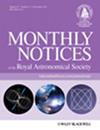宏凝聚类星体Q2237+0305中的自由漂浮 "行星
IF 4.7
3区 物理与天体物理
Q1 ASTRONOMY & ASTROPHYSICS
引用次数: 0
摘要
有人声称,场类星体的可变性类似于由质量∼10 M⊕的自由浮游行星组成的庞大宇宙群体所产生的引力透镜。但另一方面,银河系测光监测实验却排除了大量这种行星质量引力透镜的存在。如果所考虑的天体的平均柱密度介于这两种情况下引力透镜的临界柱密度之间,那么这些看似矛盾的证据就可以调和。众所周知,这种形式的暗物质具有弱碰撞性,因此在星系晕密度剖面中会形成一个核心,而且已经建立了一个首选模型。在这里,我们考虑了这种模型对Q2237+0305的影响,Q2237+0305是被一个介入星系强透镜作用的类星体的最佳研究实例。我们构建了与该类星体四幅宏观图像相适应的微透镜放大图--所有这些图像都是通过星系隆起看到的。每张放大图都显示了一个由恒星产生的苛性网络,以及由透镜星系中自由漂浮的 "行星 "产生的许多孤立的小苛性。行星 "对放大率直方图的影响很小,但对放大率梯度的统计却有很大影响。我们将预测结果与已公布的 Q2237+0305 的 OGLE 光度测量结果进行了比较,发现这些数据与假想 "行星 "的存在是一致的。然而,证据相对较弱,因为 OGLE 数据集并不适合测试我们的预测,在此应用中需要低通滤波。为了解决这个问题,需要从大型天基望远镜获得新的数据。本文章由计算机程序翻译,如有差异,请以英文原文为准。
Free-floating ‘planets’ in the macrolensed quasar Q2237+0305
It has been claimed that the variability of field quasars resembles gravitational lensing by a large cosmological population of free-floating planets with mass ∼10 M⊕. But Galactic photometric monitoring experiments, on the other hand, exclude a large population of such planetary-mass gravitational lenses. These apparently contradictory pieces of evidence can be reconciled if the objects under consideration have a mean column-density that lies between the critical column-densities for gravitational lensing in these two contexts. Dark matter in that form is known to be weakly collisional, so that a core develops in galaxy halo density profiles, and a preferred model has already been established. Here we consider what such a model implies for Q2237+0305, which is the best-studied example of a quasar that is strongly lensed by an intervening galaxy. We construct microlensing magnification maps appropriate to the four macro-images of the quasar — all of which are seen through the bulge of the galaxy. Each of these maps exhibits a caustic network arising from the stars, plus many small, isolated caustics arising from the free-floating “planets” in the lens galaxy. The “planets” have little influence on the magnification histograms but a large effect on the statistics of the magnification gradients. We compare our predictions to the published OGLE photometry of Q2237+0305 and find that these data are consistent with the presence of the hypothetical “planets”. However, the evidence is relatively weak because the OGLE dataset is not well suited to testing our predictions and requires low-pass filtering for this application. New data from a large, space-based telescope are desirable to address this issue.
求助全文
通过发布文献求助,成功后即可免费获取论文全文。
去求助
来源期刊

Monthly Notices of the Royal Astronomical Society
ASTRONOMY & ASTROPHYSICS-
CiteScore
9.10
自引率
37.50%
发文量
3198
审稿时长
3 months
期刊介绍:
Monthly Notices of the Royal Astronomical Society is one of the world''s leading primary research journals in astronomy and astrophysics, as well as one of the longest established. It publishes the results of original research in positional and dynamical astronomy, astrophysics, radio astronomy, cosmology, space research and the design of astronomical instruments.
 求助内容:
求助内容: 应助结果提醒方式:
应助结果提醒方式:


